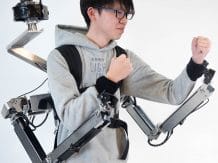Researchers from Tel Aviv University boasted of creating a new type of lie detector, which is said to be much more effective than a traditional polygraph. Best of all, the technology already available on the market was used to create the device.
The new lie detector works on the basis of electrodes produced by the Israeli company X-trodes, which are sensitive enough to be used to monitor sleep, detect neurological diseases or monitor the health of athletes during comprehensive examinations. Scientists used them to track the activity of muscles and nerves located under the skin of the face. Monitoring this activity has proven to be an excellent way of detecting when a person is starting to lie.
The new lie detector may turn out to be quite a risky technology
Many studies have shown that it is almost impossible to tell when someone is lying to you. The existing lie detectors are so unreliable that their results are not acceptable as evidence in court – because almost anyone can learn to control their pulse and trick the machine. Accordingly, there is a great demand for more accurate fraud identification technology. Our study is based on the premise that facial muscles warp when we lie and that so far no electrode has been sensitive enough to measure these bends.
– says the author of the study, Professor Dino Levy
The team tested the performance of their prototype detector with an experiment in which participants paired up and sat down facing each other. One person from each pair received headphones in which two words were played in random order: a line and a tree. The person with the earphones over their ears was told to repeat the word to their partner that he was just hearing. Or lie. Human partners, of course, could not distinguish between truth and lies. But the device using X-trodes electrodes coped with this task perfectly.
Also read: How to cheat lie detector?
The electrodes were attached to two groups of facial muscles: the cheek muscles near the lips and the muscles just above the eyebrows. Electrical signals generated by these muscle groups were sent to a computer with a machine learning algorithm that analyzed these signals on an ongoing basis in terms of the truthfulness of the subject. Result? The new lie detector has reached 73 percent. effectiveness. The developers say that this result can still be improved. The question of fine-tuning the algorithm. At least when it comes to detecting simple lies:
Since this was a preliminary study, the lie itself was very simple. Usually, when we lie in real life, we are telling a longer story that has both deceptive and truthful elements. In our study, we had the advantage of knowing what the participants heard through the headphones and therefore also knowing when they were lying. using advanced machine learning techniques, we have trained our program to recognize deception based on EMG (electromyography) signals. We achieved 73% efficiency using this method – not a perfect result, but the efficiency we achieved is still much better than that offered by any existing technology. Well, we discovered that people lie with the help of different facial muscles: some lie with the muscles of their cheeks and others with their eyebrows
Says Levy.
Scientists are of course to be congratulated on discovering a new way to test truthfulness. The question is, what will happen with this knowledge. It is probably just a matter of time before we create sufficiently precise cameras recording the image in a high enough resolution that they will be able to monitor the work of both muscle groups used when telling the untruth. This would mean that a technology capable of detecting lies based on video recordings in sufficiently high definition would appear on the market, which any totalitarian regime in the world would probably dream of.
Levy admits that a further goal of his research will be to get rid of the electrodes, replace them with image analysis and further improve the algorithm. On the one hand, this technology would certainly help with many investigations. On the other hand, it could strip ordinary citizens of their privacy.






![1458055104-bionic-heart-patch[1]](https://www.bitcoinminershashrate.com/wp-content/uploads/2021/07/1626757790_Israeli-scientists-created-the-heart-of-a-cyborg-218x163.jpg)








